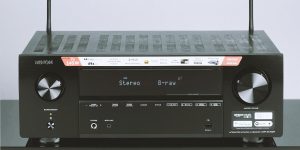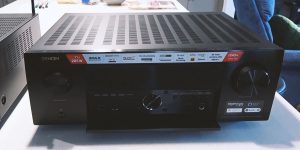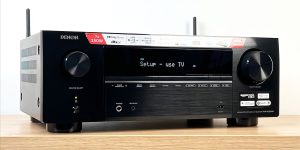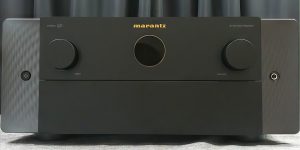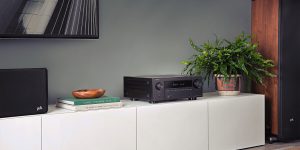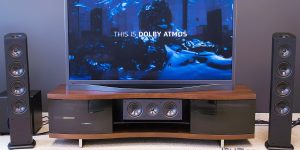The Yamaha RX-V lineup has an extensive history from the 90s, evolving significantly as they have implemented numerous updates and enhancements compared to the original models. When a company aims to incorporate an abundance of features into a single product while targeting a specific price point, some compromises become inevitable to achieve that balance. My Yamaha RX-V6A review is dedicated to the most powerful model of the RX-V series, which already has a large army of fans all over the world and quite possibly will interest you, too.
Design

As usual, the design is pretty much the same as other receivers on the market. However, one of the drawbacks is its remote control. It does not have many of the functions of the older (but favored by many users) remote control that Yamaha has offered. They also removed the ability to control other devices. So, I had to use several different remotes to control the RX-V6A. Uncomfortable? Absolutely!
The next issue is the display, which you can hardly notice. Changing the settings is more intuitive, but the menus look like the 90’s. I didn’t like the plastic front panel as well as the loose knobs. However, it’s obvious that Yamaha just needed to skimp on these things to make the price affordable. I have no questions or complaints about the other components.
Features and specs

RX-V6A specifications start with 100W (8 ohms, 20Hz-20kHz, 0.06% THD), making it a powerful device in its price class that is capable of driving high-quality immersive audio speaker configurations. In addition, the device offers an adaptive DRC. The DA converter is the same as the previous model, RX-V4A, which has 384 kHz / 32-bit. Talking about audio, the AM radio it provides is kind of useless and sounds terrible. The FM tuner sounds harsh and unrefined. It’s obvious they don’t expect us to use such a device for a radio. By the way, the antennas they provide are also of bad quality plastic.
The Yamaha RX-V6A offers various connectivity options to accommodate various video sources. There are 7 HDMI inputs and a single output, but I wish there were at least one HDMI connection in front for easy access. It supports 8K/60Hz, 4K/120Hz, HDR10+, Dolby Vision, HLG, ARC and eARC. Note that if you’re okay with HDMI 2.0, this receiver will work for you. However, RX-V6A turned the sound off, and sometimes, the screen went black, and this happened to every HDMI input. The equipment also upscales to 4K, but, for me, there’s no great increase in the sharpness of the video. Still, the added live quality is a plus. I also noticed a great improvement in clarity with native 4K content.
Of course, the equipment includes standard network and wireless capabilities for convenience. There are built-in Wi-FI (2.4 / 5 GHz) and Bluetooth (with SBC / AAC codecs). You can also enjoy a range of included streaming services and control it all with the help of Voice control. However, note that Bluetooth transmitter won’t transmit audio from any of your HDMI inputs if you want to use only the audio portion on a Bluetooth transmission to send to an external outdoor speaker.
The main reason why you may consider purchasing the Yamaha AV receiver is that it can decode Dolby Atmos content and has the ability to create overhead sound virtualization even without dedicated overhead speakers, as well as DTS:X. In addition to these immersive audio formats, it also supports various surround sound formats such as Dolby TrueHD, DTS-HD Master Audio, and Dolby Digital Plus. One thing this receiver lacks is a good equalizer. However, you may choose party mode and enhance the sound.
The greatest disappointment of all its users is the manuals, which don’t come in the box. You will have to look for it on the Internet (which is more than 200 pages) to figure out all the settings. The good news is that you can save all your settings on a USB or memory save your setup. So if something happens, you won’t struggle setting it up again thanks to a single button or just reloading configurations right off the USB.
Listening experience
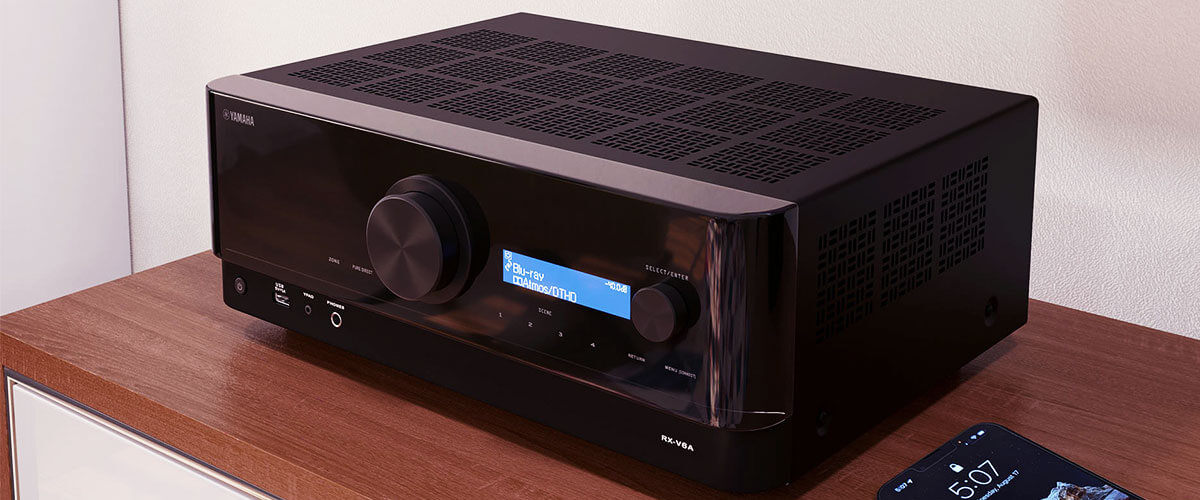
As an Atmos receiver, it performs well, and with the help of my old pair of front speakers (no center channel) from another home theater system, it sounded even deeper and more spacious. I especially liked the Atmos capabilities while watching sci-fi and action movies. When in the phono mode, the unit switches automatically to a 4-channel stereo, and you’ll get the stereo in the front as well as the rears. If put on surround sound mode, the unit will create a spacious effect that follows the loudness of the individual instruments in the left and right channels.
There’s also the addition of imaging from the front presence speakers, which adds dimension to vinyl playback, CDs, and YouTube music. The clarity is good, and the noise level is undetectable. The unit is also quiet and stays cool. Cause when I was listening to the music for a good long time, the amplifier stayed just slightly warm. Overall, the sound of the Yamaha RX-V6A is clear but not that rich.
Key specs
- Channels: 7.2.
- Power output: 100W/8 Ohm.
- HDMI inputs/outputs: 7/1.
- Video functions: 8K/60Hz, 4K/120Hz, 4K/60Hz pass-through, video upconversion (up to 1080p and 8K) for analog and HDMI sources.
- Bluetooth/Wi-Fi: yes/yes.
- Streaming services: AirPlay 2, Pandora, Spotify, Napster, SiriusXM, TIDAL, Deezer, Qobuz, Amazon Music, MusicCast.
- Suppots: HDMI ARC, HDMI eARC, HDMI CEC, HDCP2.3, HDR10, HDR10+, Dolby Vision.
- Surround sound: DTS HD Master, Dolby TrueHD, Dolby Digital Plus, Cinema DSP.
We are supported by our audience. When you purchase through links on our site, we may earn an affiliate commission at no extra cost to you.
Our newsletter
* We will never send you spam or share your email with third parties

![Best Stereo Receivers [Reviewed and Tested]](https://mediapro-av.com/wp-content/uploads/2024/01/best-stereo-receiver-300x150.jpg)

